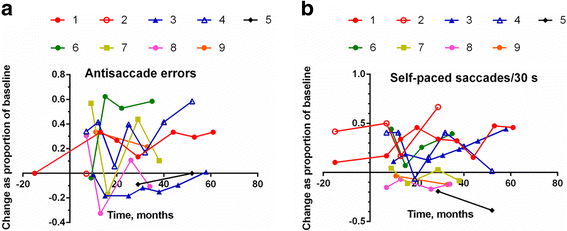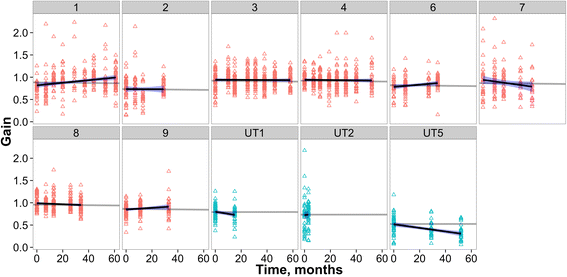Longitudinal assessment of reflexive and volitional saccades in Niemann-Pick Type C disease during treatment with miglustat
- PMID: 26691656
- PMCID: PMC4687063
- DOI: 10.1186/s13023-015-0377-8
Longitudinal assessment of reflexive and volitional saccades in Niemann-Pick Type C disease during treatment with miglustat
Abstract
Background: Niemann-Pick Type C disease (NPC), is an autosomal recessive neurovisceral disorder of lipid metabolism. One characteristic feature of NPC is a vertical supranuclear gaze palsy particularly affecting saccades. However, horizontal saccades are also impaired and as a consequence a parameter related to horizontal peak saccadic velocity was used as an outcome measure in the clinical trial of miglustat, the first drug approved in several jurisdictions for the treatment of NPC. As NPC-related neuropathology is widespread in the brain we examined a wider range of horizontal saccade parameters and to determine whether these showed treatment-related improvement and, if so, if this was maintained over time.
Methods: Nine adult NPC patients participated in the study; 8 were treated with miglustat for periods between 33 and 61 months. Data were available for 2 patients before their treatment commenced and 1 patient was untreated. Tasks included reflexive saccades, antisaccades and self-paced saccades, with eye movements recorded by an infrared reflectance eye tracker. Parameters analysed were reflexive saccade gain and latency, asymptotic peak saccadic velocity, HSEM-α (the slope of the peak duration-amplitude regression line), antisaccade error percentage, self-paced saccade count and time between refixations on the self-paced task. Data were analysed by plotting the change from baseline as a proportion of the baseline value at each test time and, where multiple data values were available at each session, by linear mixed effects (LME) analysis.
Results: Examination of change plots suggested some modest sustained improvement in gain, no consistent changes in asymptotic peak velocity or HSEM-α, deterioration in the already poor antisaccade error rate and sustained improvement in self-paced saccade rate. LME analysis showed statistically significant improvement in gain and the interval between self-paced saccades, with differences over time between treated and untreated patients.
Conclusions: Both qualitative examination of change scores and statistical evaluation with LME analysis support the idea that some saccadic parameters are robust indicators of efficacy, and that the variability observed across measures may indicate locally different effects of neurodegeneration and of drug actions.
Figures






Similar articles
-
Miglustat in Niemann-Pick disease type C patients: a review.Orphanet J Rare Dis. 2018 Aug 15;13(1):140. doi: 10.1186/s13023-018-0844-0. Orphanet J Rare Dis. 2018. PMID: 30111334 Free PMC article. Review.
-
Saccades in adult Niemann-Pick disease type C reflect frontal, brainstem, and biochemical deficits.Neurology. 2009 Mar 24;72(12):1083-6. doi: 10.1212/01.wnl.0000345040.01917.9d. Neurology. 2009. PMID: 19307542
-
Saccadic eye movement characteristics in adult Niemann-Pick Type C disease: relationships with disease severity and brain structural measures.PLoS One. 2012;7(11):e50947. doi: 10.1371/journal.pone.0050947. Epub 2012 Nov 30. PLoS One. 2012. PMID: 23226429 Free PMC article.
-
Miglustat for treatment of Niemann-Pick C disease: a randomised controlled study.Lancet Neurol. 2007 Sep;6(9):765-72. doi: 10.1016/S1474-4422(07)70194-1. Lancet Neurol. 2007. PMID: 17689147 Clinical Trial.
-
[Adult onset Niemann-Pick type C disease and psychosis: literature review].Encephale. 2013 Oct;39(5):315-9. doi: 10.1016/j.encep.2013.04.013. Epub 2013 Aug 5. Encephale. 2013. PMID: 23928063 Review. French.
Cited by
-
Miglustat in Niemann-Pick disease type C patients: a review.Orphanet J Rare Dis. 2018 Aug 15;13(1):140. doi: 10.1186/s13023-018-0844-0. Orphanet J Rare Dis. 2018. PMID: 30111334 Free PMC article. Review.
-
Smartphone video nystagmography using convolutional neural networks: ConVNG.J Neurol. 2023 May;270(5):2518-2530. doi: 10.1007/s00415-022-11493-1. Epub 2022 Nov 23. J Neurol. 2023. PMID: 36422668 Free PMC article.
-
Inborn Errors of Metabolism with Ataxia: Current and Future Treatment Options.Cells. 2023 Sep 19;12(18):2314. doi: 10.3390/cells12182314. Cells. 2023. PMID: 37759536 Free PMC article. Review.
-
Video-Oculography Assessment in Neurodegenerative Ataxias and Niemann Pick Type C.Noro Psikiyatr Ars. 2024 May 25;61(2):101-106. doi: 10.29399/npa.28563. eCollection 2024. Noro Psikiyatr Ars. 2024. PMID: 38868844 Free PMC article.
-
Measuring saccades in patients with Niemann-Pick type C: A comparison between video-oculography and a novel eye tracking test based on continuous psychophysics.Clin Park Relat Disord. 2022 Oct 26;7:100170. doi: 10.1016/j.prdoa.2022.100170. eCollection 2022. Clin Park Relat Disord. 2022. PMID: 36338825 Free PMC article.
References
Publication types
MeSH terms
Substances
LinkOut - more resources
Full Text Sources
Other Literature Sources
Medical
Research Materials

